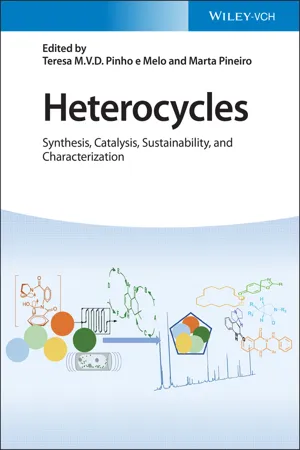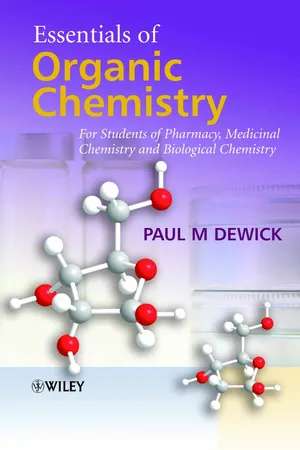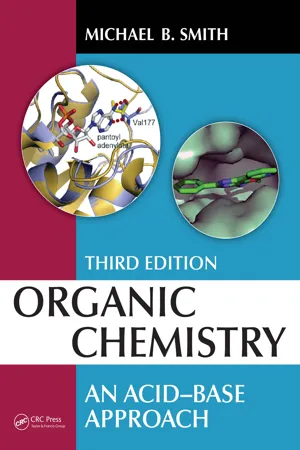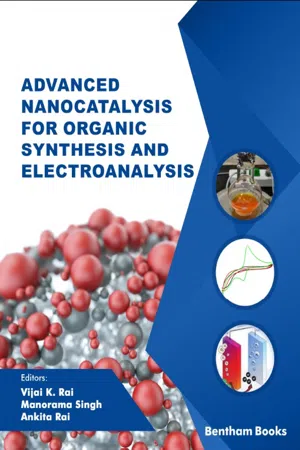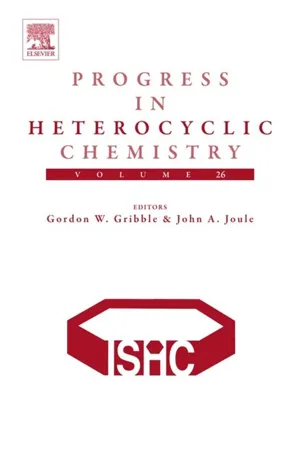Chemistry
Heterocyclic Chemistry
Heterocyclic chemistry is the study of organic compounds containing at least one ring structure with atoms other than carbon. These atoms are typically nitrogen, oxygen, or sulfur, and the presence of heteroatoms imparts unique chemical and biological properties to these compounds. Heterocyclic compounds are widely used in pharmaceuticals, agrochemicals, and materials science due to their diverse reactivity and functional diversity.
Written by Perlego with AI-assistance
6 Key excerpts on "Heterocyclic Chemistry"
- eBook - ePub
Heterocycles
Synthesis, Catalysis, Sustainability, and Characterization
- Teresa M. V. D. Pinho e Melo, Marta Pineiro(Authors)
- 2022(Publication Date)
- Wiley-VCH(Publisher)
1 Heterocyclic Compounds in Enantioselective Photochemical ReactionsNorbert HoffmannUniversité de Reims Champagne-Ardenne, CNRS, ICMR, Equipe de Photochimie, UFR Sciences, B.P. 1039, Reims, 51687, France1.1 Introduction
The present chapter deals with different key topics. Heterocyclic compounds play a central role in many domains of chemistry such as the search of new biologically active compounds in pharmaceutical and agricultural chemistry [1] . Also, many new materials such as semiconducting compounds contain heterocyclic moieties [2] . In these domains, a large structural diversity and molecular complexity is highly needed. Here, traditional methods of organic synthesis find their limits. Photochemical reactions extend such limits. As electronic excitation completely changes the chemical reactivity of compounds or whole family of compounds [3] , products, which cannot be synthesized by more conventional methods become accessible and are of high interest for application in the field of bioactive compounds [4 , 5 ]. Furthermore, the outcome of known reactions, especially catalytic reactions, can be improved when they are carried out under photochemical conditions. Based on the enormous quantity of recent and past results in the field of photochemical reactions, it makes sense to subdivide chemical reactions into two classes: reactions that occur in the electronic ground state and reactions in which electronic excitation is involved. From the economic and ecological point of view, photochemical reactions are particularly interesting, since many of them can be carried out without an additional chemical reagent. The photon is considered as a traceless reagent [6 , 7 ]. For these reasons, these reactions are now highly appreciated in chemical and pharmaceutical industry [8 –10 ].Stereoselectivity also plays a central role in organic synthesis. Biological activity and material properties strongly depend on the stereochemistry of chemical compounds. Sooner or later, almost all synthesis methods will face this problem. In the past, photochemical reactions have been considered as being inherently stereo-unselective. It was thought that the high energy uptake by light absorption induces uncontrolled relaxation processes that lead to unselective reactions with large amounts of degradation either of the substrates or the photoproducts [11] . In this regard, it must however be pointed out that stereoselective and stereospecific photochemical reactions have been known from the very beginning of this research area [12 , 13 ]. The controlled dissipation of the high electronic excitation energy in photochemical reactions is the reason for the high stereoselectivity in such reactions [11] . In particular, photochemical reactions can be conducted enantioselectively in chiral supramolecular structures [14 , 15 - eBook - ePub
Essentials of Organic Chemistry
For Students of Pharmacy, Medicinal Chemistry and Biological Chemistry
- Paul M. Dewick(Author)
- 2013(Publication Date)
- Wiley(Publisher)
11 Heterocycles 11.1 Heterocycles Cyclic compounds in which one or more of the ring atoms is not carbon are termed heterocycles ; the noncarbon atoms are referred to as heteroatoms. We shall limit our discussions to compounds in which the heteroatoms are nitrogen, oxygen, or sulfur. For the purposes of studying and understanding their properties, heterocycles are conveniently grouped into two classes, i.e. non-aromatic and aromatic. 11.2 Non-aromatic heterocycles We have already met many examples of non-aromatic heterocycles in earlier chapters, e.g. cyclic ethers (see Section 6.3.6), including epoxides (see Section 8.1.2), and cyclic amines (see Section 7.7.1), as well as lactones (see Section 7.9.1), lactams (see Section 7.10), and cyclic acetals and ketals (see Section 7.2). From the familiar examples shown below, it should be clear that the standard approach to generating heterocyclic systems requires a difunctional compound containing a leaving group or electrophilic centre, together with a nucleophilic species that provides the heteroatom. The nomenclature of simple heterocyclic ring systems containing one heteroatom is indicated overleaf. These form a useful reference, but there is little to be gained in committing them to memory. Note, however, that the most important of these structures tend to have a trivial rather than systematic name, a consequence of long-standing common usage. Some of these, e.g. tetrahydrofuran and tetrahydropyran, are derived from the name of the corresponding aromatic heterocycle by the concept of reduction. A few examples of commonly encountered heterocycles with two heteroatoms are also shown. Numbering always begins at the heteroatom; in the case of morpholine, numbering starts at oxygen, the heteroatom of higher atomic number. Remember that an accepted alternative in nomenclature is to indicate a heteroatom by the prefix aza-, oxa, or thiain the appropriate carbocycle (see Section 1.4) - eBook - ePub
Organic Chemistry
An Acid-Base Approach
- Michael B. Smith(Author)
- 2022(Publication Date)
- CRC Press(Publisher)
23 Heteroaromatic Compounds
DOI: 10.1201/9781003174929-23The video clips for this chapter are available at: https://routledgetextbooks.com/textbooks/9780367768706/chapter-23.phpThe scientist photographs are also available at:https://routledgetextbooks.com/textbooks/9780367768706/image-gallery.phpHeterocycles or heterocyclic aromatic compounds are a class of aromatic compounds in which heteroatoms replace one or more of the ring carbons. Heterocycles and their chemistry comprise a vast area of chemistry and an entire course is easily built around them. However, the focus of this chapter will be nitrogen, oxygen, and sulfur heterocycles. This chapter also discusses reduced heterocycles, which are cyclic molecules that contain nitrogen, oxygen, or sulfur. Alkaloids are a class of nitrogenous organic compounds of plant origin that have pronounced physiological actions on humans.To begin this chapter, you should know the following points:- Hydrocarbon and heteroatom functional groups (Sections 5.1, 5.2, 5.3, 5.5, and 5.6).
- Aromaticity (Sections 19.2 and 19.8).
- Organic bases (Section 6.7).
- Electrophilic aromatic substitution (Section 19.3).
- Nucleophilic aromatic substitution (Section 19.10).
- Alkene chemistry (Sections 10.1–10.7).
- Ketones and aldehydes (Sections 5.6.2, 16.1, and 116.2).
- Carboxylic acid derivatives (Sections 5.6.3, 18.4–18.90).
- Acyl addition reactions (Sections 16.2–16.4).
- Acetal and ketal formation (Section 16.4.2).
- Imine and enamine formation (Section 16.4.3).
- Acyl substitution (Section 18.4).
- Isomers (Section 4.2.2).
- The E1 reaction (Section 12.4).
23.1 Nitrogen, Oxygen, and Sulfur in an Aromatic Ring
N-Containing 5 and 6-Membered RingsThere are several heterocycles that contain one or two nitrogen atoms. The five-membered ring compound with one nitrogen is called pyrrole, a constituent of coal tar and it is found in bone oil. The IUPAC numbering scheme for pyrrole begins with nitrogen and extends around the ring. The orbital with the unshared electron pair on the nitrogen atom is parallel to those for the four π-electrons of the C=C units. This arrangement gives an aromatic six π-electron system. The hydrogen atom on nitrogen is forced to be perpendicular to the aromatic π-cloud but it is coplanar with the carbon atoms and nitrogen. Although pyrrole is a secondary amine it is not basic because electron donation would disrupt the aromaticity of the ring. Indeed, the hydrogen atom on the nitrogen of pyrrole is somewhat acidic, with a pKa - Vijai K. Rai, Manorama Singh, Ankita Rai(Authors)
- 2022(Publication Date)
- Bentham Science Publishers(Publisher)
INTRODUCTION
Heterocyclic compounds are the largest class of organic compounds that exhibit a variety of interesting pharmacological activities. Among the different classes of heterocycles, nitrogen and oxygen heterocycles are part of various natural products and compounds of biological significance [1 ]. Consequently, considerable effort has been devoted to the development of synthetic methodologies for these heterocycles, especially the five- and six-membered nitrogen and oxygen heterocyclic compounds [2 , 3 ]. Some of the well-known examples of medicinally important heterocycles include ciprofloxacin 1, which is a wide spectrum antibiotic drug used for the treatment of respiratory tract infections and urinary tract infections [4 ], and the antibacterial drug sulfamethox-azole 2, which is used to treat urinary tract infections in patients with a kidney transplant (Fig.Fig. (1)) Representative examples of biologically active heterocycles.) [5 ].1Furthermore, brexipiprazole 3 is an example of antipsychotic drug used for the treatment of the major depressive disorder (MDD) [6 ] and osimertinib 4 is widely used for the treatment of non-small cell lung cancer [7 ]. The oxygen heterocycle digoxin 5 is an effective drug for the treatment of irregular heartbeats and heart failure [8 ].Numerous conventional methods are available in the literature for the synthesis of these biologically relevant heterocycles and some of the downsides of many of these approaches involve expensive catalysts, harsh reaction conditions, toxic solvent, high temperature, and multistep synthetic sequence. Consequently, in recent years, synthetic chemists are paying more attention to the development of greener strategies involving nanocatalysts for the synthesis of these valuable heterocycles [9- eBook - ePub
Water Quality Data
Analysis and Interpretation
- Arthur Hounslow(Author)
- 2018(Publication Date)
- CRC Press(Publisher)
CHAPTER 7Organic Chemistry NomenclatureIntroduction
Organic compounds are composed primarily of variable numbers of carbon and hydrogen atoms, usually with smaller numbers of oxygen, nitrogen, sulfur, phosphorus, and halogen atoms—chlorine, fluorine, and bromine. Other elements may be incorporated in organic compounds to form organometallic compounds, but those will not be discussed here. Although specific references are generally not practical in this chapter, the text “Nomenclature of Organic Compounds” by Fletcher et al. (1974) was relied on extensively when nomenclature problems arose.The carbon atoms are joined to one another as chains, branched structures, or in rings. The carbon-carbon bonds may be single (sharing one electron pair), double (sharing two electron pairs), or triple (sharing three electron pairs). The most important ring structure, benzene, is one that consists of six carbon atoms and six hydrogen atoms in a planar ring. If a noncarbon atom replaces a carbon in a ring structure, the compound is called a heterocyclic compound. Most of the variation among organic compounds is caused by special groups of organic atoms attaching to the carbon atoms. They are called functional groups and contain at least one noncarbon atom. It is the presence of these groups that give organic compounds their unique properties. Organic compounds containing only carbon and hydrogen are called hydrocarbons. If they contain one or more halogen atoms they are called halogenated hydrocarbons. They may be divided into two groups, depending on whether the benzene ring is present or not. These are listed in Table 7.1 .Early Organic Chemistry
The term organic chemistry was originally used to designate those substances of plant and animal origin thought to be more closely related to one another than to subsiances of mineral origin. It was known that organic substances form CO2 and H2 - eBook - ePub
- (Author)
- 2014(Publication Date)
- Elsevier(Publisher)
Chapter 2Heterocyclic Chemistry
A Complete Toolbox for Nanostructured Carbon Materials
Luisa Lascialfari, Stefano Fedeli and Stefano Cicchi∗ Università degli Studi di Firenze, Firenze, Italy ∗ Corresponding author: E-mail: [email protected]Abstract
The functionalisation of fullerene, carbon nanotubes and graphene, to form heterocyclic derivatives is described, demonstrating the fundamental role of Heterocyclic Chemistry in the fast growing area of materials chemistry.Keywords
Aziridines; C60 ; Carbon nanotubes; Epoxides; Fullerenes; Graphene; Imidazoline; Isoxazoline; Nanotechnology; Oxazine; Oxazoline; Piperidine; Pyran; Pyridazine; Pyrrolidine; Pyrroline; Tetrahydrothiophene2.1. Introduction
Nanostructured carbon materials (hence NCMs) (fullerenes, carbon nanotubes (CNTs) and graphene, just to cite the most renowned) are just starting to change our life and show promise to bring about a real revolution in science and technology: they have found application in nanomedicine (13ADR1899 , 10MI287 ), in nanoelectronics for the production of electronic devices and sensors (12AN6541 , 10MI333 ), and in the production of composites with new properties (12CSUC456 ).These materials represent an important sector of nanotechnology, i.e., the science that produces, studies, and finds application for objects with dimensions between 1 and 100 nm. [60]Fullerene 1 (from now on C60 ) is the smallest representative with a 1 nm diameter (considering the electron cloud) and is special since it is a molecule with defined composition and molecular weight, while CNTs 2 and graphene 3 are macromolecules characterized by at least one nanometric dimension. Their composition and structure (only sp 2 carbon atoms arranged in a honeycomb lattice, for CNT and graphene, or in a truncated icosahedron for C60 ) confer special and unprecedented properties such as mechanical resistance, conductivity, and ability to pass easily through cell walls. However, to profit from these characteristics, it is necessary to be able to handle these materials and to modify them. C60 is insoluble in polar solvents, is sparingly soluble in toluene (2.8 mg/mL), and is appreciably soluble in 1,2-dichlorobenzene (27 mg/mL) or 1-chloronaphthalene (51 mg/mL) (93JPC3379 ). Moving to graphene (13CC3721 ) and CNTs (06CR1105 , 10CR5366
Index pages curate the most relevant extracts from our library of academic textbooks. They’ve been created using an in-house natural language model (NLM), each adding context and meaning to key research topics.
Explore more topic indexes
Explore more topic indexes
1 of 6
Explore more topic indexes
1 of 4
